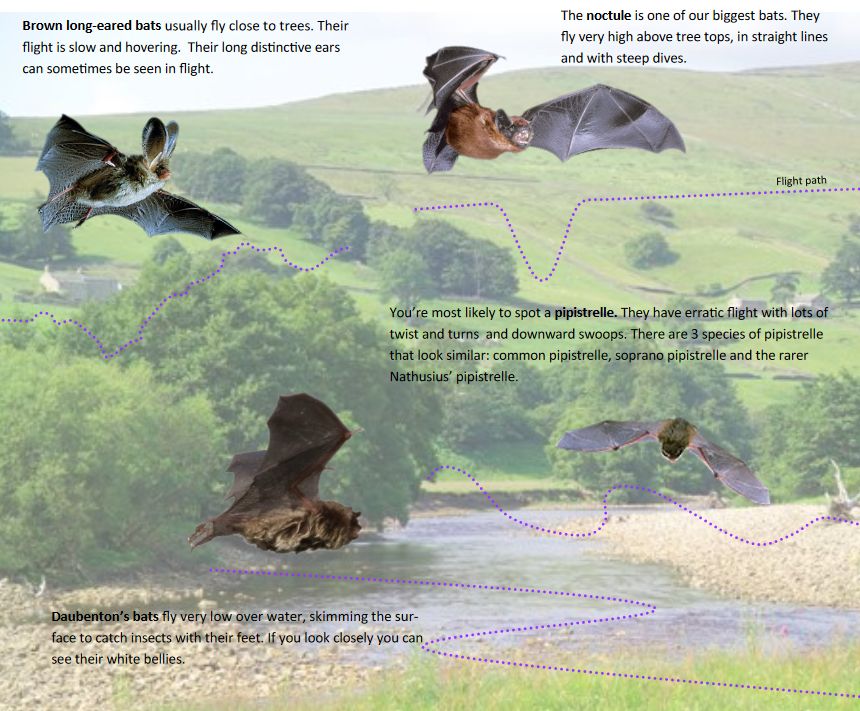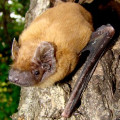If you see bats, many factors can help you take a educated guess at the most likely species. Things to look out for include:
- Size of bat: Large bat flying like a bird, or small bat with flittering flight?
- Speed, and pattern of flight: Slow flapping high along the treetops, erratic flight or skimming over water?
- Foraging habitat: Is it feeding in woodland, or widely swooping over a meadow?
- Type of roost it emerged from: Under the fascia of a modern house, hanging in a old barn, or emerging from a hole in a tree?
Below is a good summary of four most common species you are most likely to see in Somerset.

The Natural History Museum have also produced a excellent guide to Bat ID to download.
Listed below more details about Somersets commonest bats.
PIPISTRELLE (COMMON AND SOPRANO)

Pipistrelles are the commonest and most widespread of all British bat species and the ones you are most likely to see. They appear fast and jerky in flight, and feed in a wide range of habitats comprising woodland, hedgerows, grassland, farmland, suburban and also urban areas.
They generally emerge from their roost around 20 minutes after sunset and fly 2-10m above ground level searching for their insect prey, which they catch and eat on the wing by
‘aerial hawking’.
Summer roosts of both pipistrelles are usually found in crevices around the outside of newer buildings, such as behind hanging tiles, soffit or eaves boards, between roofing felt and roof tiles or in cavity walls. They also roosts in tree holes and crevices, and sometimes in bat boxes.
- Link to full Species Factsheet on BCT website. Listen to their echolocation
BROWN LONG-EARED

Brown long-eared bats are medium-sized. The ears are nearly as long as the body but not always obvious: when at rest they curl their ears back like rams’ horns, or tuck them away completely under their wings leaving only the pointed inner lobe of the ear (the tragus) visible.
As well as catching insects in free flight, brown long-eared bats are gleaners, often flying slowly amongst foliage, picking insects off leaves and bark. Their broad wings and tail allow
slow, highly manoeuvrable, hovering flight. Their flight often includes steep dives and short glides.
These bats are known as ‘whispering bats’ because their echolocation sounds are very quiet. They have particularly sensitive low frequency hearing and often locate prey from the sounds made by the insect’s own movements. They may sometimes use vision.
Their habit of flying close to the ground, or even landing to tackle prey, makes long-eared bats vulnerable to attack by predators.
Summer roosts are usually located in older buildings, barns, churches and trees. Long-eared bats generally form small and quiet colonies of about 20 animals.
- Links to full Species Factsheet on the BCT website. Listen to their echolocation
Noctule

The noctule bat is one of the largest British species and is usually the first bat to appear in the evening, sometimes even before sunset. They have a characteristic powerful, direct flight on narrow pointed wings. Noctule bats fly in the open, often well above tree-top level, with repeated steep dives when chasing insects. They can fly at 50 kph.
Most food is caught on the wing and eaten in flight but occasionally prey is taken from the ground and in suburban areas noctules are attracted to street lamps to feed on moths.
Noctule bats are primarily tree dwellers and live mainly in rot holes and woodpecker holes. They occur rarely in buildings
- Links to full Species Factsheet on the BCT website. Listen to their echolocation.
Daubenton

Daubenton’s bat is a medium-sized species. It has a steady flight, often within a few centimetres of the water surface and is reminiscent of a small hovercraft. They usually take insects from close to the water and can be seen taking prey directly from the water surface, using their large feet as a gaff or the tail membrane as a scoop.
The majority of known summer colonies are in humid, more or less underground sites near water. These may be tunnels or bridges over canals and rivers, or in caves, mines and cellars. They are only occasionally found in buildings, usually old stone structures.
- Links to full Species Factsheet on the BCT website. Listento their echolocation.
WANT MORE INFORMATION?
Also have a look at the our page on the “most common and rarest Bat species in Somerset“, which has species factsheets for all the resident bats.
Want to go out and see bats for yourself? Then head to our “How to watch Bats” and “Where to look for bats” pages
Got the bat bug, and want to listen in to the bats echolocation? Then have a look at our page on choosing a bat detector.